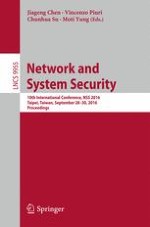This book constitutes the proceedings of the 10th International Conference on Network and System Security, NSS 2016, held in Taipei, Taiwan, in September 2016.
The 31 full and 4 short papers presented in this volume were carefully reviewed and selected from 105 submissions. They were organized in topical sections named: authentication mechanism; cloud computing security; data mining for security application; privacy-preserving technologies; network security and forensics; searchable encryption; security policy and access control; security protocols, symmetric key cryptography; system security; Web security. The volume also contains one invited paper.
